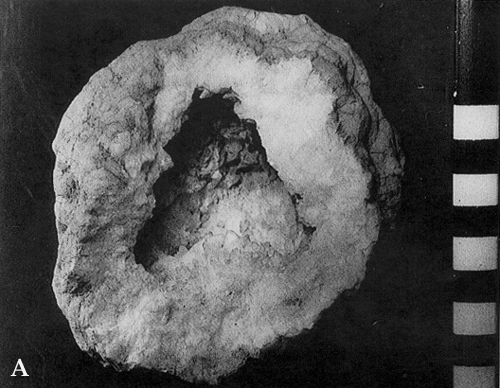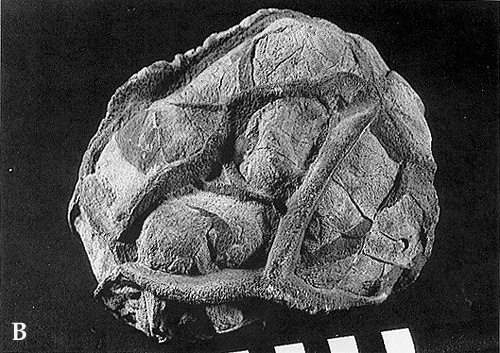

Hollow concretions: geode (A) and septarian "nodule" (B)
Plate 174


Hollow concretions: geode (A) and septarian "nodule" (B)
Plate 174
A geode is an isolated cavity lined by crystals that grow inward; a druse is an open, sheetlike cavity, or fissure, also coated by crystals. The crystals are usually macroscopic, with regular faces developed on their free ends: in the example shown here, coming from a sulfur mine in Messinian evaporites, the mineral is celestine (strontium sulfate). When the crystals are very small, the coating is in the form of bands or crusts of different thickness and colors draping the cavity walls.
The concretion shown in plate 174 B is called septarium (plural: septaria ) because of its external aspect. The interior, not shown, consists of a cracked concentric layer (cavity coating, with inward widening cracks), sometimes with a breccia at the core (due to collapse of fragments from the coating). The cracks and the residual cavity are partially or totally filled by a second generation of chemical precipitates, usually in the form of macroscopic crystals. The second generation mineral is harder than the first one, which is removed more easily by weathering; that is why the crack fills appear as ridges (septa ) on the external surface, with a typical reticulate pattern.
All these concretions are, originally, gel-like masses in which dehydration and crystallization occur with time; the loss of water causes shrinkage and the opening of a cavity. Before hardening, a hollow concretion cannot withstand an overload, which implies that crystallization occurs under a shallow burial depth.
The samples are part of the collection of the Department of Geological Sciences, University of Bologna. Scale in centimeters.
| Photo: P. Ferrieri 1992. |